Apple scab is a fungal disease that can devastate apple trees, resulting in disfigured fruit and leaves. Identifying and treating apple scabs is a top priority for growers and is key to maintaining orchard health and productivity. This guide provides the insights needed to detect the disease, understand its life cycle, and implement effective control measures.
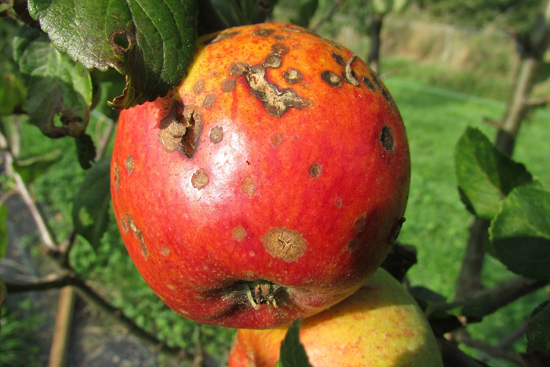
Key Takeaways
• Apple scabs caused by the fungus Venturia inaequalis significantly affect apple tree yield and health. Early symptom recognition and understanding of the pathogen’s life cycle are crucial for effective management.
• Preventive measures, including appropriate orchard sanitation, the use of disease-resistant apple cultivars, and cultural practices, are key to reducing the incidence of apple scab; applying fungicides at the right time can also effectively control outbreaks.
• Amidst outbreaks, swift action is necessary, such as pruning to remove infected parts and potentially seeking professional help; maintaining overall tree health and vitality through optimal care practices is essential for disease resistance and orchard success.
Understanding Apple Scab and Its Impact on Orchards
Apple scab, the notorious plant disease caused by the fungus Venturia inaequalis, is a formidable adversary for apple cultivators. This ascomycete fungus has an interesting life cycle that involves the production of ascospores, a type of spore formed within a sac-like structure called an ascus. The apple scab fungus capitalizes on the early spring season to launch its attack, making it a prevalent threat during this period.
The impact of apple scab is not to be underestimated. Infected trees exhibit leaf spots, lesions, and infected fruit, all of which can reduce the yield and quality of the harvest. The disease has a significant impact on orchards, affecting not only the productivity of the trees but also their overall health. This makes it crucial for growers to identify and manage apple scabs effectively to maintain the prosperity of their orchards.
Recognizing Symptoms of Apple Scab
The first step towards managing apple scab is recognizing its symptoms. Infected trees initially exhibit olive green apple scab leaf spots on leaves and fruit, marking the onset of the disease. These spots can appear on both surfaces of older leaves and on the underside of young leaves, making them a key indicator of infection. As the disease progresses, apple scab lesions may also develop on the fruit and leaves.
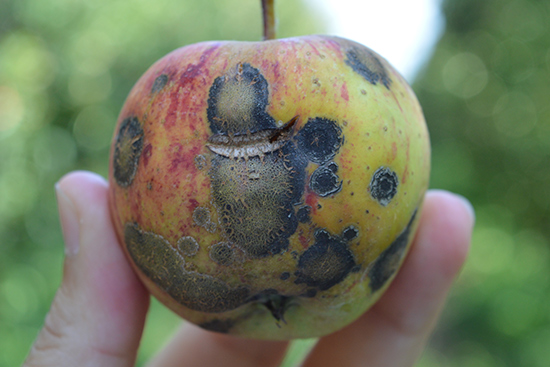
As the disease progresses, the spots evolve into velvety-grey to black lesions that give the plant tissue a blistered appearance. The infection can escalate to the point where the leaves can:
• twist
• distort
• stunt
• fall prematurely
This can lead to severe damage. Recognizing these symptoms early on is crucial for effective apple scab management.
How Apple Scab Fungus Overwinters
The apple scab fungus is a master of survival, overwintering in infected fallen leaves and waiting for the right moment to launch a new attack. During the winter and early spring, the fungus forms pseudothecial initials within these fallen leaves, which later release ascospores capable of infecting new leaves. The fungus relies on sexual reproduction to develop these pseudothecia, a process that takes place in the leaf debris.
With the arrival of early spring and the bud break of apple trees, the primary ascospores mature and become ready for infection. Understanding this overwintering process is key to predicting the timing of apple scab infections and implementing effective control measures.
Identifying Hosts of the Apple Scab Pathogen
Although apple scab primarily affects apple cultivars and various species of crabapple within the Malus genus, it does not discriminate against other hosts. The pathogen can also infect a variety of other plants, including:
• Cotoneaster integerrima
• Crataegus oxycantha (Hawthorn)
• Sarcocephalus esculantus
• Sorbus (Mountain Ash)
• Viburnum
This wide host range makes effective management of apple scabs crucial to maintaining the health of apple orchards and other susceptible plant species.
Timing and Conditions Favoring Apple Scab Infections
Timing and environmental conditions play significant roles in the spread and severity of apple scab infections. The disease favors:
• cool and wet conditions in early spring
• a higher discharge rate of ascospores from the late pink bud stage through petal fall
• temperatures ranging from 61 to 75°F
Infections rarely occur at temperatures above 78°F.
The duration of leaf wetness also influences the infection process. At moderate temperatures between 61 to 75°F, a minimum of 6 continuous hours of leaf wetness is necessary for infection. To calculate the risk of primary apple scab infection, growers can use the Revised Mills Table, considering the average temperature during the leaf wetness period and the duration of this wetness. Understanding these conditions can help growers predict apple scab infection periods and implement preventive measures accordingly.
Preventive Measures Against Apple Scab
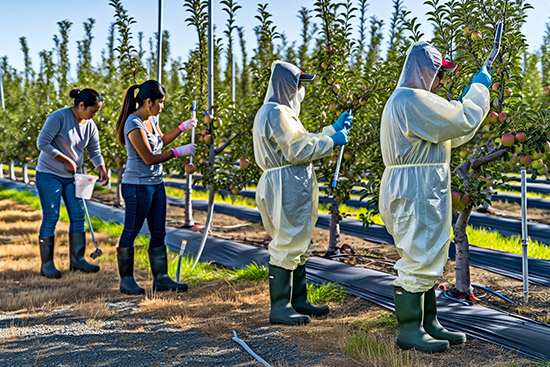
Prevention is a crucial part of managing apple scab. Implementing cultural practices such as maintaining proper tree spacing for air movement, pruning for better air circulation, and keeping tree crowns open can significantly reduce the risk of infection. Pruning to open the tree canopy during winter can also aid in lowering apple scab incidence by improving air circulation and sunlight penetration, allowing for faster foliage drying.
Another vital aspect of prevention involves sanitation. Removing and destroying infected leaves and fruit at season’s end can significantly reduce the number of fungal spores that could cause new infections. Choosing resistant cultivars is also an important preventive measure, offering a significant line of defense in managing this disease.
Choosing Scab Resistant Cultivars
Choosing resistant cultivars is one of the best defensive strategies against apple scab. Several apple cultivars exhibit resistance to the disease, including:
• Crimson Crisp
• Enterprise
• Liberty
• Goldrush
• Pristine
Bred for their resilience against apple scab, these cultivars can play a significant role in disease management.
In addition to apples, certain crabapple varieties also show resistance to apple scab. These include Prairiefire, Red Jewel, and Sugar Tyme. Using these resistant cultivars can significantly reduce the incidence of apple scab in your orchard, providing an essential line of defense against this relentless pathogen.
Sanitation Practices to Reduce Infection
Sanitation practices also play a critical role in preventing apple scab. One such practice involves applying urea to apple trees after harvest but before leaf drop in the fall to expedite leaf decomposition. This reduces the number of overwintering spores of the apple scab fungus, which can significantly decrease the potential for new infections in the next growing season.
Another critical sanitation practice is raking and disposing of fallen leaves and fruit, which removes the primary source of fungal spores and breaks the apple scabs’ infection cycle. Pruning and appropriately discarding infected leaves from the tree is also an essential method to diminish the amount of fungal inoculum present, curtailing the start of the disease cycle the following season.
Effective Treatment Options for Apple Scab
Despite the best preventive measures, apple scab may still find a way to infiltrate your orchards. In such cases, effective treatment options are essential. Several chemical fungicides, including Myclobutanil and synthetic options like Organocide® Plant Doctor, have proven effective in controlling apple scabs. These fungicides work by inhibiting the growth of the fungus, thereby preventing further spread of the disease.
Organic treatment options are available for those seeking more natural solutions. These include sulfur-based sprays and biopesticides such as Bonide® Orchard Spray and Serenade ASO. These organic treatments offer a more environmentally friendly approach to managing apple scabs, providing effective control without the use of harsh chemicals.
Applying Fungicides at Key Times
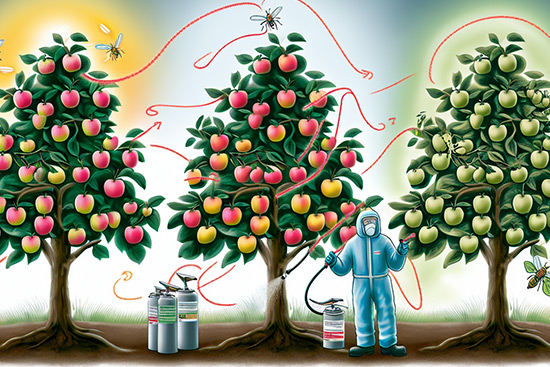
When it comes to fungicide application, timing is everything. Fungicide sprays should begin at the ‘½” green tip’ stage for ornamental and edible crabapple and apple trees when the first green leaf tips appear in the spring. This early application helps to prevent the establishment of the apple scab fungus before it can cause significant damage.
Ascospore dissemination marks a critical period for fungicide applications. It coincides with the time from bud break to the end of bloom. This is when the fungus is most actively spreading, indicating when fungicides are most crucial. Repeat fungicide applications should be guided by monitoring for scab lesions and continued until the majority of the flower petals have fallen.
Fungicide label recommendations generally suggest a spray interval between 7 and 10 days, with the frequency adjusted based on rainfall and previous scab issues. Mid-June examinations of leaves for scab lesions inform the need for continued spraying to manage secondary infections throughout the growing season. Effective fungicide application requires a combination of the right timing, frequency, and persistence.
Organic Approaches to Managing Apple Scab
Organic fungicides offer an effective solution for those seeking a more natural approach to managing apple scab. Organic options like Bonide® Orchard Spray with sulfur, pyrethrins, and liquid copper soap are used as sprays for managing the disease. These treatments work by inhibiting the growth of the fungus, similar to chemical fungicides, but without the potential environmental impact.
Liquid copper soap should be sprayed two weeks before apple scab symptoms usually appear or at the first sign of disease, with subsequent applications at 7 to 10-day intervals up to blossom drop. Wettable sulfur products, such as Bonide® Sulfur Plant Fungicide, can be applied from pre-blossom stages before rainy periods or spore discharge through cover sprays up to the day of harvest. As with any treatment, these organic methods should be used with consideration for protecting pollinators during the apple scab management process.
Tackling Severe Apple Scab Outbreaks
In the face of severe apple scab outbreaks, prompt and assertive action is necessary. Pruning is a critical step in managing such outbreaks to maintain the tree’s health and potential yield. By removing infected leaves and tissues, the spread of the fungus can be minimized, protecting the remaining healthy tissue from infection.
The apple scab fungus can cause significant damage, including fruit drop, by infecting blossoms, sepals, and pedicels. To prevent further infection and enhance tree health, it is important to take the following steps:
1. Properly prune the tree to remove diseased or dead branches. This will improve air circulation in the canopy.
2. Act fast and decisively to limit the spread of the disease.
3. Minimize the impact of the disease on the tree.
By following these steps, you can effectively treat apple scab and protect your tree.
When to Seek Professional Help
There may be instances when apple scab has spread significantly, or the treatment requires a complex schedule, making it necessary to consult tree care professionals. Professional arborists can assess the specific situation of your orchard or garden and offer a quote along with a customized treatment plan.
Booking professional treatment services early, especially from April through July, ensures availability and timely management of apple scab.
The Economic and Aesthetic Toll of Apple Scab
The impact of apple scab extends beyond the health of the trees. The disease can lead to extensive economic losses, in some cases exceeding 70%, for apple growers due to both direct fruit loss and indirect losses like repeated defoliation that stunts tree growth and yield. Infections from apple scabs reduce fruit size and quality, causing distortions and uneven growth, which can lead to cracking in the skin and flesh, thereby diminishing the marketability of the apples.
Apple scab has several negative effects on apple trees:
• It causes deformed leaves and fruit, affecting the trees’ overall appearance.
• This can lower the visual quality perceived by consumers.
• Growers face economic pressures from consumer demands for reduced chemical use.
• Ongoing management of pathogen resistance is necessary.
The battle against apple scab is not just about maintaining the health of the trees but also about preserving the economic viability and aesthetic appeal of the orchards.
Nurturing Healthy Trees Beyond Apple Scab
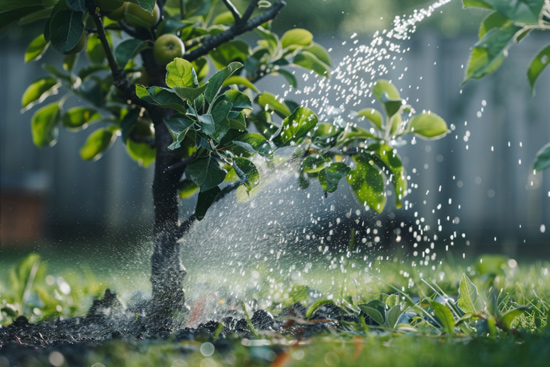
While managing apple scabs is crucial, nurturing overall tree health is equally important. Maintaining tree vigor enhances apple trees’ disease-resistance capabilities, making them more resilient to infections and better equipped to cope with stress induced by apple scabs and other diseases. Optimally planting, timely fertilization, and proper pruning techniques can achieve robust tree health.
Practices such as appropriate watering schedules and protection of the trees’ roots and bark are critical to minimizing stress and bolstering the trees’ disease defenses. Healthy apple trees not only stand a better chance against apple scab but are also more capable of producing high-quality fruit, ensuring the prosperity of your orchards.
Enhancing Tree Vitality
Enhancing tree vitality requires a combination of good planting practices, proper fertilization, and appropriate watering. Maintaining soil pH levels between 6.0 and 6.5 is critical for optimal growth of apple trees. Applying a thick layer of compost under trees can minimize splash dispersal of fungal spores and provide trees with the necessary nutrients. A 2-3 inch layer of organic mulch helps in weed control and preserves soil moisture, both important for tree vitality.
Regular deep watering during the first five years after planting supports establishing a strong root system in apple trees. Fertilization should be based on soil tests to provide necessary nutrients without excessive vegetative growth, which can attract pests and diseases.
To ensure proper fertilization:
• Conduct soil tests to determine nutrient deficiencies
• Apply fertilizers according to the recommended rates
• Avoid over-fertilization, especially with nitrogen, to prevent issues like reduced fruit set, pest problems, and environmental harm.
By following these guidelines, you can promote healthy growth and productivity in your apple trees while preventing apple disease.
By enhancing tree vitality, you can ensure a healthier and more resilient orchard, especially for your fruit trees.
Apple Scab Summary
The battle against apple scab is multifaceted, requiring knowledge, vigilance, and effective management strategies. From understanding the disease and its impact on orchards, recognizing its symptoms, adopting preventive measures, choosing resistant cultivars, and implementing effective treatment options – managing apple scab is a continuous process that extends well beyond the disease itself. It involves nurturing healthy trees, enhancing their vitality, and ensuring their resilience against current and future threats. Armed with this knowledge, you are now better equipped to protect your orchards and maintain the health and prosperity of your apple trees, ensuring a bountiful harvest season after season.
Frequently Asked Questions
These are the more common questions readers have about apple scab in Alpharetta, Georgia:
How do you treat apple scab?
To treat apple scabs, choose scab-resistant apple varieties, regularly remove fallen leaves or fruit, and keep the tree crowns open for good airflow. Consider using fungicides with proper timing as an additional management measure. A synthetic fungicide like Myclobutanil can also be effective, as it is applied from the green tip until after the petals fall.
Is it safe to eat apples with apple scab?
Yes, it is safe to eat apples with apple scab, as the lesions are superficial and do not affect the fruit’s safety.
What are the first signs of apple scab?
The first signs of apple scab, which may often go unnoticed, include twisted and puckered leaves with black, circular, scabby spots on the underside and velvety olive-green spots on the upper surface. Watch out for these symptoms to catch apple scab early.
Does apple scab affect other trees?
Yes, apple scab affects other trees, such as crabapple, hawthorn, mountain ash, and pear, among others. It primarily impacts trees in the rose family.
What is apple scab, and how does it affect orchards?
Apple scab is a fungal disease that primarily affects apple and crabapple trees. It causes leaf spots, lesions, and infected fruit, ultimately reducing the yield and quality of the harvest.
This article was first published on: https://www.72tree.com/apple-scab-disease-and-treatment/